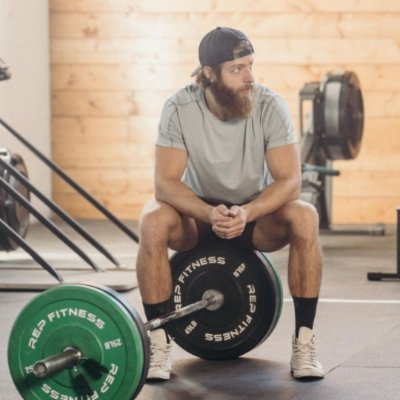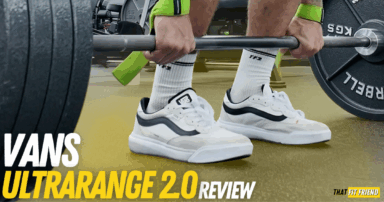If you’re a tall lifter then you’re probably well aware that some exercises in the gym can be a “little” more difficult for you. Long legs, arms, and torsos are not always the best for technically efficient lifts.
As someone who suffers from what I call “LLS” long leg syndrome (sarcasm, obviously!), I have to constantly fine-tune my squats, presses, and deadlifts to work with my anatomy and body’s strengths.
In this article, I’m going to cover five of my favorite deadlift tips for tall lifters. If you’ve been struggling with improving your deadlift, then the tips below should help you increase your deadlift strength and improve your form.
Key Takeaways
- Unlike in squats and bench presses, tall lifters can actually gain an awesome advantage with deadlifts if they can learn how to leverage their longer limbs.
- If you have long legs, the quads can be an incredible asset when used properly to improve your strength when breaking the floor and increase your power production.
- It’s okay to modify your deadlift execution to align with your goals. If something isn’t clicking, then using a different variation or reverse engineering can stimulate more growth.
Author’s Note: If you’re constantly struggling with your deadlift and nothing is clicking, feel free to reach out via Instagram (@jake_boly), and I can try to help out accordingly. I also have my YouTube video covering these tips embedded below.
Tip 1: Check Your Hip Height
The first tip and thing deadlift form variable that I’d suggest assessing with your deadlift is where your hips are positioned regarding their height. If you notice your hips shooting up in your deadlift, this tip can be huge for you.
Oftentimes, I’ll see tall lifters sit too low for their anatomy and deadlift mechanics. Remember, if you’re a taller lifter, your form will look different than other lifters, especially our shorter peers.
A big lesson and reminder that I’d love to convey throughout all these tips are that your deadlift might look different than other lifters due to limb length variance. Deadlift form is individual and the goal is to find what works for you, not to replicate what another lifter is doing.
If you’re sitting too low in your deadlift, it’s normal for the hips to rise too quickly and tension to be lost before the lift even starts. If this is you, you may want to adjust your hip height.
The Fix: Select a moderate load on the bar that is about 70-85% of your 1-RM. I’d suggest starting lighter to get a feel for different hip positions, then increasing the weight on the bar slightly as you acclimate and feel more comfortable.
Example Deadlift Day:
- 5×2 @ 75%
- 5×2 @ Ascending load starting at 70% and ending around 80-85%
- 4×4 @ 70%
I suggest these ranges because you don’t want to go so light to where you’re not challenged at all. For example, it’s easy to maintain a position at 60% or less of our 1-RM, but that doesn’t paint the full picture of how your body will self-organize as weight and demands increase.
Video yourself from the side and record all of your deadlift sets. You’ll want to focus on your hip position and what the hips are doing during the first half of your pull.
If you notice them rising at all before the barbell does, then you’ll want to bring your hips higher and shift your knees a little more forward to get more quad out of your pull. Ideally, you don’t want to see a ton of up-and-down hip movement in the first part of your deadlift.
It’s going to feel awkward bringing your hips higher, but if you’re not noticing them shoot up during your pull, then you’re likely on a good track. If you’ve adjusted your hip height, I’d suggest running a position for 2-3 weeks and videoing yourself to both acclimate to this change and assess if you’re being consistent.
Tip 2: Use Your Quads
I alluded to this above, but the quads in the deadlift can be a huge asset for tall lifters. If you’re taller, you have to lift the weight through a greater range of motion than a shorter lifter. This is why a strong deadlift stance is important for tall lifters.
If you under-leverage the quads when breaking the floor in the deadlift, then there’s a good chance you’re asking your posterior muscles to work harder than they have to and losing out on your potential to create more power to get the weight moving.
This tip also goes hand-in-hand with the tip above about adjusting your hip height. For example, just because you bring your hips up does not mean to have to adapt an RDL-like hip hinge for the entirety of the deadlift.
If you notice that your shins are perfectly vertical in your deadlift or like your lower back and posterior are doing most of the work when starting your deadlifts, then you’ll want to implement this tip.
The Fix: While maintaining your hip position and height, bring your knees forward slightly. The idea of “vertical shins” in the deadlift is misleading and your shin angle should always be relative to your anatomy and deadlift mechanics.
By bringing your knees forward, you’ll get more out of your quads when breaking the floor (initiating your deadlift) and this can help get the weight moving to a point in which your hamstrings, glutes, and back muscles can help finish and lock out the pull.
I like to conceptualize this by noting that the quads are helping you to start your momentum, then as you pass mid-shin, the posterior muscles are coming into play to assist and finish out the deadlift as they’ll be better poised to help you lock out the weight.
A cue that I like to use for leveraging your quads more in your deadlift is to think about “pushing” the earth away, or to pretend you’re on a leg press and pushing the platform away as you start your deadlift.
Tip 3: Slow Down for Big Gains
Another tip that I find works well for tall lifters is to have them utilize a slower deadlift tempo for a training block or two. I know slowing down seems counterproductive, but hear me out.
The deadlift is a concentric-focused lift, this means that the brunt of the work you’re doing in the deadlift is through the lifting portion of the movement. Unless you’re training for velocity and power — which is not relevant to this tip — there’s power in slowness.
Oftentimes, I find that tall lifters tend to freak out when deadlifts get heavier and start to slow down. I think this is due to the greater range of motion these lifters have to lift the weight as the brain somewhat panics as effort increases tenfold.
By slowing down, you can teach the brain to not panic nearly as much as weight increases. It can also teach you to stay in the pocket and get better at fighting big pulls when you will be working for multiple seconds to lock out a rep.
As an added benefit of slowing down deadlifts for a strength block or two, you can also identify lapses in form, as a slower tempo will help highlight things like the hips shooting up or underleveraging the quads, glutes, etc.
The Fix: For a block or two where you’re working on your deadlift strength, add a purposeful 2-3 second tempo to your concentric or lifting portion of your deadlift. As weight increases, you’ll likely hit this tempo naturally without having to count.
For this block, make a point to video yourself for a few sessions. Video yourself from a front diagonal angle and from the side on sets where you’re purposely hitting reps with a prescribed tempo.
When you watch your videos back, you’ll want to watch your hips and legs and assess what they’re doing. By doing this, you’ll not only build the skill of staying in heavy deadlifts, but you’ll also be able to identify areas where your form may be falling short.
Tip 4: Leverage Your Arms
If you have long limbs and more specifically long arms, then you’ll want to make sure you’re leveraging their length in your deadlift. Low-key, long arms are a superpower for big deadlifts.
Far too often, I see lifters, and more specifically tall lifters, not utilizing their arms to the most of their abilities. This shortcoming typically comes in two forms, 1) a lifter’s deadlift grip is too wide, and 2) they’re not thinking about their arms as hooks.
Think about it this way, if you’re already lifting your deadlifts higher than most lifters due to your height, what is one way you can make sure you’re cutting down on your total work output? By lengthening your long arms.
The Fix: Video yourself from the front and from a diagonal angle during your next deadlift session. To make sure you’re properly leveraging your arm length, you’ll want to look for two things.
First, look at your arm angle with the ground. Ideally, you want your arms relatively perpendicular to the ground. This will give you more length out of them and if your arms look like an upside-down “V” at lockout, then you’ll probably want to bring your grip in.
Second, look at your setup from a side angle. In a perfect world, you’re letting your arms simply hang and not oversetting the scaps. If you’re oversetting the upper back, then you’re likely bringing the arms up, losing out on their length, and overextending the upper back.
To work around the habit of oversetting, I want you to simply think about “letting your arms hang” when setting up and starting your deadlifts. The lats and upper back muscles will keep your arms in their sockets; there’s no need to overdo your set.
Tip 5: Work With Your Anatomy
The last tip is to work with your anatomy and not force an exercise for arbitrary reasons. For example, I constantly see lifters do what I refer to as trying to fit square pegs into round holes regarding their exercise selection.
In the context of being a taller lifter and deadlifting, if you find that no matter what, you can’t get your deadlift form dialed in and something isn’t clicking, then you may want to re-engineer your deadlift.
This means that you’ll use deadlift variations that allow you to push your performance and work the deadlift skill without sacrificing intensity with something that isn’t working. Also, if you’re not a competitive powerlifter and need the deadlift for competition reasons, then there’s no shame in drilling other deadlift variations.
Note, this tip can take many forms and when in doubt, I’d suggest working with a coach, but I’ll share some examples of how I help tall lifters work around this below.
The Fix: If you’re finding that your posterior muscles are letting you down in your deadlift or like your form is breaking as you pass the mid-shin area with your range of motion, then I’d suggest playing with block pulls.
A block pull will set the barbell up slightly higher and this is typically something that tall lifters respond really well to. In the deadlift, the setup and starting position is arguably the hardest part of tall athletes, so by eliminating that range of motion you can get a lot of high-effort work out of your session without sacrificing form.
If you notice that your quads are lacking during the first part of your pull and you can’t seem to “feel” that push when starting deadlifts, then I’d suggest swapping out your barbell deadlifts with high-handle trap bar deadlifts *gasp, the trap bar!* for a block or two.
A high-handle trap bar deadlift can be great for tall lifters because you can often perform sets for a higher volume and since your arms are to the sides of the body, you’ll typically and naturally get more quads in your deadlift.
Trap bar deadlifts can be an awesome and sneaky way to train the body to get comfortable with using the quads more during both barbell deadlifts and their endless variations.
Frequently Asked Questions (FAQ)
Q:Is it harder to deadlift if you're tall?
Q:Which deadlift is best for tall people?
Q:Are deadlift dangerous for tall lifters?
Takeaway Thoughts
Contrary to popular belief, the deadlift can be a tall lifter’s best asset regarding putting up big numbers. For example, long arms can be an awesome tool for giving you more in the deadlift by cutting down on your range of motion.
If you find that you’ve been struggling with your deadlift, whether you’re tall or not, give these deadlift tips a try for a block or two to see if they create some positive carryover to your performance.
If you have additional questions about these deadlift tips and implementing them into your training, hit me in the comment below, on YouTube, or Instagram (@jake_boly or @that_fit_friend).





















T Bot
Thanks for the tips. I am 50 years old and 6’3” with kind of short arms. I have found that just putting 25 pound bumper plates on their side and under my dead lift weight has helped me a ton. Just those couple inches have made a huge difference in my set up.
That’s the name of the game. Tweak setups and movements to give you the best mechanics. Love it.